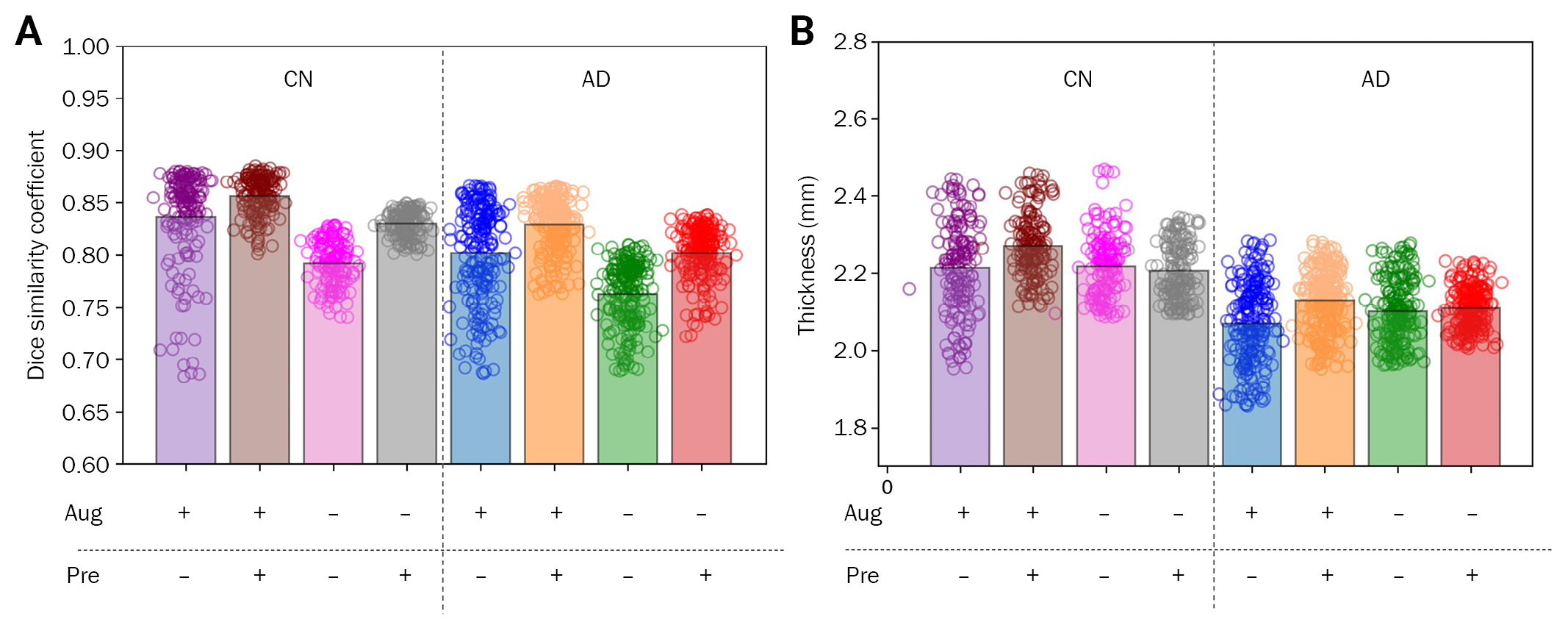2. Brundel M, van den Heuvel M, de Bresser J, Kappelle LJ, Biessels GJ; Utrecht Diabetic Encephalopathy Study Group. Cerebral cortical thickness in patients with type 2 diabetes. J Neurol Sci 2010;299:126–130.


5. Khedher L, Ramírez J, Górriz JM, Brahim A, Segovia F; Alzheimer’s Disease Neuroimaging Initiative. Early diagnosis of Alzheimer’s disease based on partial least squares, principal component analysis and support vector machine using segmented MRI images. Neurocomputing 2015;151(Part 1):139–150.

6. Ronneberger O, Fischer P, Brox T. U-net: convolutional networks for biomedical image segmentation. In: Navab N, Hornegger J, Wells W, Frangi A, editors. Medical image computing and computer-assisted intervention – MICCAI 2015. Lecture Notes in Computer Science, vol 9351. Springer; Cham: 2015. p. 234–241.

7. Milletari F, Navab N, Ahmadi SA. V-Net: fully convolutional neural networks for volumetric medical image segmentation. In: Presented at 2016 Fourth International Conference on 3D vision (3DV); October 25-28, 2016. Piscataway, NJ: IEEE; 2016. p. 565–571.

8. Çiçek Ö, Abdulkadir A, Lienkamp SS, Brox T, Ronneberger O. 3D U-Net: learning dense volumetric segmentation from sparse annotation. In: Ourselin S, Joskowicz L, Sabuncu M, Unal G, Wells W, editors. Medical image computing and computer-assisted intervention – MICCAI 2016. Lecture Notes in Computer Science, vol 9901. Springer; Cham: p. 424–432.

9. Kamnitsas K, Ledig C, Newcombe VF, et al. Efficient multi-scale 3D CNN with fully connected CRF for accurate brain lesion segmentation. Med Image Anal 2017;36:61–78.


10. Havaei M, Davy A, Warde-Farley D, et al. Brain tumor segmentation with Deep Neural Networks. Med Image Anal 2017;35:18–31.


12. Domingos P. A few useful things to know about machine learning. Commun ACM 2012;55:78–87.

13. Leung KK, Clarkson MJ, Bartlett JW, et al. Robust atrophy rate measurement in Alzheimer’s disease using multi-site serial MRI: tissue-specific intensity normalization and parameter selection. Neuroimage 2010;50:516–523.


14. Lemieux L, Wieshmann UC, Moran NF, Fish DR, Shorvon SD. The detection and significance of subtle changes in mixed-signal brain lesions by serial MRI scan matching and spatial normalization. Med Image Anal 1998;2:227–242.


15. Ghanei A, Soltanian-Zadeh H, Jacobs MA, Patel S. Boundary-based warping of brain MR images. J Magn Reson Imaging 2000;12:417–429.


16. Ashburner J, Friston KJ. Voxel-based morphometry: the methods. Neuroimage 2000;11(6 Pt 1):805–821.


17. Pereira S, Pinto A, Alves V, Silva CA. Brain tumor segmentation using convolutional neural networks in MRI images. IEEE Trans Med Imaging 2016;35:1240–1251.


18. Roth HR, Lu L, Farag A, et al. Deeporgan: Multi-level deep convolutional networks for automated pancreas segmentation. In: Navab N, Hornegger J, Wells W, Frangi A, editors. Medical image computing and computer-assisted intervention -- MICCAI 2015. Lecture Notes in Computer Science, vol 9349. Springer; Cham: 2015. p. 556–564.

19. Zhao A, Balakrishnan G, Durand F, Guttag JV, Dalca AV. Data augmentation using learned transformations for one-shot medical image segmentation. In: Presented at 2019 IEEE/CVF Conference on Computer Vision and Pattern Recognition (CVPR); June 15-20, 2019. Piscataway, NJ: IEEE; 2019. p. 8535–8545.

20. Fischl B. FreeSurfer. Neuroimage 2012;62:774–781.


22. Alkabawi EM, Hilal AR, Basir OA. Computer-aided classification of multi-types of dementia via convolutional neural networks. In: Presented at 2017 IEEE International Symposium on Medical Measurements and Applications (MeMeA); May 7-10, 2017. Piscataway, NJ: IEEE; 2017. p. 45–50.

23. Akhila JA, Markose C, Aneesh RP. Feature extraction and classification of dementia with neural network. In: Presented at 2017 International Conference on Intelligent Computing, Instrumentation and Control Technologies (ICICICT); July 6-7, 2017. Piscataway, NJ: IEEE; 2017. p. 1446–1450.

24. Dolph CV, Alam M, Shboul Z, Samad MD, Iftekharuddin KM. Deep learning of texture and structural features for multiclass Alzheimer’s disease classification. In: Presented at 2017 International Joint Conference on Neural Networks (IJCNN); May 14-19, 2017. Piscataway, NJ: IEEE; 2017. p. 2259–2266.

25. Faturrahman M, Wasito I, Hanifah N, Mufidah R. Structural MRI classification for Alzheimer’s disease detection using deep belief network. In: Presented at 2017 11th International Conference on Information & Communication Technology and System (ICTS); October 31, 2017. Piscataway, NJ: IEEE; 2017. p. 37–42.

27. Islam J, Zhang Y. A novel deep learning based multi-class classification method for Alzheimer’s disease detection using brain MRI Data. In: Zeng Y, He Y, Kotaleski JH, , editors. International Conference on Brain Informatics-BI 2017. Lecture Notes in Computer Science, vol 10654. Springer; Cham: 2017. p. 213–222.

29. Kumar P, Nagar P, Arora C, Gupta A. U-segnet: fully convolutional neural network based automated brain tissue segmentation tool. In: Presented at 2018 25th IEEE International Conference on Image Processing (ICIP); October 7-10, 2018. Piscataway, NJ: IEEE; 2018. p. 3503–3507.

30. Thyreau B, Taki Y. Learning a cortical parcellation of the brain robust to the MRI segmentation with convolutional neural networks. Med Image Anal 2020;61:101639.


32. Azami H, Sanei S, Mohammadi K. A novel signal segmentation method based on standard deviation and variable threshold. Int J Comput Appl 2011;34:27–34.











 PDF Links
PDF Links PubReader
PubReader ePub Link
ePub Link Full text via DOI
Full text via DOI Full text via PMC
Full text via PMC Download Citation
Download Citation Supplement1
Supplement1 Print
Print



